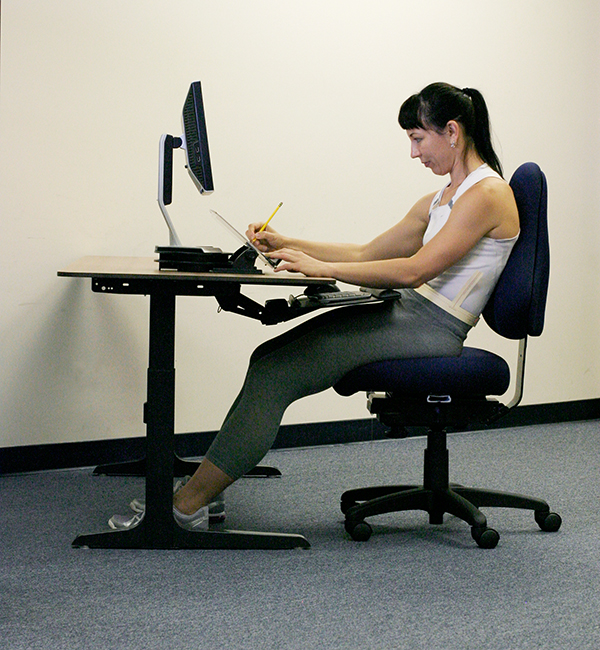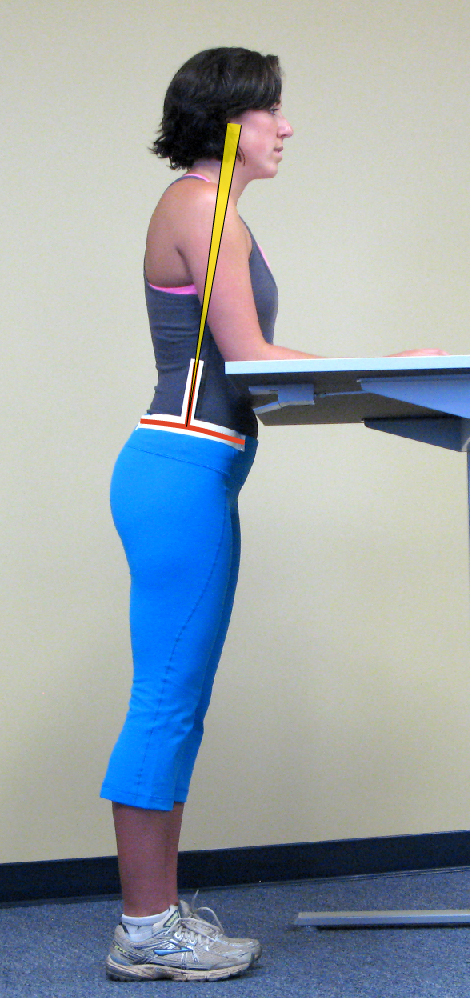Do we really need to stand at work to solve the health risks from sitting?
Recent press says that your chair is a killer, but let’s be clear about what we know. Much of the writing suggests that the passive inactivity of the chair causes damage to our metabolism and mental acuity. If the sedentary behavior of sitting is associated with obesity, heart disease and diabetes, then simply increasing activity seems like a reasonable solution. Until we look closely, sitting can easily be confounded as the cause of those diseases. When the real health risk is not clear, the quick solution may be only a guess about what is best, and the unintended consequences may be worse.
Well-researched scientific studies associate sitting posture with higher risks for serious health problems: obesity, diabetes, heart disease and cancer. Many of those studies that describe the health risks from sitting look only at leisure time behavior, or sitting time not counting work, and those results may not apply to a working population. Because posture changes how the body manages blood sugar and cholesterol, we need to look more closely at work postures to make better decisions about what is really healthy. The discussion to stand at work should also include the known health risks from standing. Standing at work can be an expensive solution that does not solve the original problem, and may even cause additional health risks. Research that specifically looked at the effect of sitting time at work on health risk did not find a consistent association (van Uffelen 2010).
One of the larger studies on sitting, done by the American Cancer Society (Patel 2010) followed the health history of 123,000 people over fourteen years, and asked them to report on their sitting and physical activity, not counting work. The health of people at the two extremes for the most and least activity levels, and the amount of time sitting at leisure were compared. Those people who sat the most (> 6h), and were the least active (<24 MET-h/wk) had a two-fold greater risk to die from all causes than those who sat the least (>6h) and were the most active. The median age of the study group was almost 64 years old, meaning half of the study members were older. If just the extremes for the amount of sitting (>6 vs. <3 hours/day) time are compared for that group, the risk of mortality was 1.2 for men and 1.3 for women, meaning that those who sit the most will have a 20-30% greater likelihood to die from all causes than those who sit least. These results suggest that leisure time activity is important, particularly for heart disease, but the study did not consider work activity in the mix of risk factors, and did not measure the health risk for sitting time at work.
The disturbing fifty-year rise in obesity, diabetes and heart disease may be confounding if sitting at work is not the problem. In fact, sitting at work may not cause the same health risk as sedentary leisure time activities. A critical review of sitting research was published (van Uffelen 2010) that found limited evidence to show a consistent positive relationship for sitting time at work and body mass, heart disease or cancer. Only three of the 43 papers studied found that sitting at work was associated with a higher risk of diabetes, and it may be the way people sit that causes the risk.
Posture changes physiology
The greater caloric demand of standing rather than sitting doesn’t entirely address why standing lowers disease risk. The body spends more calories to stand and walk than to sit, but the calorie difference between standing and sitting for two hours every day amounts to less than 100 calories per day. That amount of activity does not entirely explain why health changes so dramatically when the postural muscles become more active.

When the postural muscles are relaxed, the enzyme that controls normal blood sugar and fatty acids is inactivated within minutes. The serious health risks linked to sitting seem to be related to relaxed and leisure sitting, and not more active upright postures.
Changing posture changes physiology!
When the postural muscles hold the torso upright, whether for standing, walking or upright sitting, an enzyme called lipoprotein lipase (LPL) is activated by the deep postural muscles in the back and legs that manages blood sugar and fatty acid metabolism in a healthy way (Bey 2003, Hamilton 2004, Owen 2010). Research connects the most serious health risks to leisure sitting. The muscle enzyme is inactivated within minutes after the postural muscles relax. It is reclined or slump sitting and the relative sustained inactivity of the muscle enzyme during that posture that is the causal connection to diabetes, cholesterol and blood pressure problems, obesity and heart disease.
The problem with sitting is sitting badly
Research has reported on the various combinations of sitting and standing solutions that are used at work, and there are mixed results. There are also studies that show more health risks by increasing work activity by standing and walking (Krause 2007, Tuchsen 2005), there is low compliance when there is an option to stand (Wilks 2006, Gilson 2012, Straker 2013, Robertson 2013), and limited benefit when introducing an exercise program at work (Lowe 2014). A study on postural variation (Davis 2014) reported no difference in symptoms or productivity between sit-stand workstations and conventional workstations, but did show a significant improvement in some symptoms with break software.
Our ActivSeating™ strategy integrates the chair and workstation to support how the body functions best. When the deep postural muscles are able to move readily and easily, the physiology of the body improves, and the normal mechanisms for blood sugar, fatty acids and cholesterol metabolism are restored. Most importantly, when better sitting postures are easier to sustain, the original stiffness and pain problems that nag the neck and back are resolved.
Musculoskeletal risks from slumping
There is good reason to suggest that slumped seating is a contributor to cumulative trauma and orthopedic problems in the spine. It’s important to consider how we sit, rather than simply blame sitting as the cause of deteriorating health. It is worse to suggest that standing will solve the problems caused by slumped sitting, particularly when the standing solution may cause other health risks. We often expect a “good, ergonomic” chair to solve the problem. Unfortunately, using only one chair adjustment may support a good posture for one kind of work, and the very worst posture for another job!
Slumping is a subtle movement that is the cause of spinal stiffness and pain problems (Twomey 1982, Little 2005, O’Sullivan 2006, Mork 2009, Freeman 2010).
Slumping is a problem because it is subtle, and we don’t usually see when the spine is fully bent forward. Slumped posture causes an even greater problem as we get older, and is the cause of gradual stiffness and pain in the spine—either the neck, or back, or both.
The ActivSeating™ method uses the body’s natural strength and movement to encourage the postural muscles to work more easily and more often. When the postural muscles are engaged, slumped postures are minimized and orthopedic problems like cumulative trauma are more easily managed. The musculoskeletal trouble is the primary concern at work in the short term, but long-term physiology is important, too. It is important to note that the ActivSeating principles meet the body’s physiologic and orthopedic needs, without the added cost or effort to stand at work.
Does more activity at work really lower health risks?
If sedentary postures and low activity is a health problem, it seems simple enough that more activity should be a good solution. A review of research studies on exercise at work suggests there was little preventive benefit for neck and shoulder pain (Lowe 2014). A review of 38 different research studies (1997-2014) showed there was no reduction or prevention for neck and shoulder pain with most kinds of exercise at work: general resistance training, aerobic training, stretching exercise and movement awareness training did not change the report of neck and shoulder pain. There was a specific strengthening exercise prescribed as treatment for the neck and shoulder that was helpful to reduce neck and shoulder pain, but general exercise was of no benefit. As expected, long-term compliance was a problem with every exercise plan.

Spinal postures are much better for forward tasks, particularly when compared to slumped sitting. Unfortunately, the body works much harder to stand, and there are added health risks
Health Risks of Standing
Despite the better posture in the low back with standing, there are serious health risks for atherosclerosis and heart disease when we work harder to do the job in standing or walking . A study that measured work effort and the progression of thickness in the arteries showed that working harder increased the risk of atherosclerosis (Krause 2007). 612 Finnish men, 42-60 years old were studied for eleven years, comparing five different measures of energy expenditure, and controlling for virtually all other known risk factors. Spending more energy by walking or standing at work was associated with a 3-9 fold faster progression of atherosclerosis in the carotid arteries and the heart. Another large-scale study of people who stand or walk more than 75% of the day showed almost twice the likelihood to be hospitalized for varicose veins (Tu¨chsen 2005).
People don’t want to stand
Standing has some evidence to help at work: A literature review of fourteen research studies found that the adjustability of sit-stand workstations was likely to reduce perceived discomfort, and did not cause a decrease in productivity (Karakolis 2014). Unfortunately, the long-term studies suggest that people don’t want to stand. One study looked at the use of sit-stand tables one year after installation at four different companies, and showed that 60% of users stood less than once a month, and as few as one in ten used the sit-stand feature on a daily basis (Wilks 2006). Another study looked at the voluntary use of a few sit-stand tables in a large common work area, and only 10-20% of the staff used the adjustable tables (Gilson 2012). That use pattern did not change the general activity level of the group, and presumably did not lower the health risk.
A comparison of postures at a call center between users of sit-to-stand desks with users at seated desks showed that the sit-stand table users only sat 5% less (19 minutes in a six-hour shift) than people at a seated desk (Straker 2013). Just providing an adjustable table does not mean that people will use the feature. One comparison showed that people needed to be instructed to use the standing feature (Robertson 2012). even for short-term use.
Postural Variation
Postural variation, particularly with break software, seems to make a bigger difference than having a sit-stand workstation or a conventional desk (Davis 2104). The study compared postures, comfort and productivity at conventional sitting workstations and sit-to-stand workstations, and there was no significant difference in comfort or productivity between the two groups. There was a significant difference in comfort at the neck and back in both kinds of workstation when break software was used to change position. There was also a non-significant improvement (10% better) in productivity when the break software was used in both kinds of workstation.


